|
 LOGGING
WHILE DRILLING BASICS LOGGING
WHILE DRILLING BASICS
Logging while
drilling (LWD) is a technique of conveying well logging tools
downhole as part of the bottom hole assembly (BHA) while the well is
being drilled. LWD tools
transmit partial or complete measurement results to the surface via
a drilling mud-pulser or other improved techniques (Real Time Data).
Complete measurement results can be downloaded from LWD tools after
they are pulled out of the hole (Memory Data Logging). Sometimes all or
portions of the wellbore are logged or re-logged while pulling out
of the hole. This is referred to as logging while tripping.
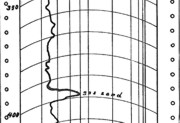 The
first patent for an LWD tool appeared in 1932, for a tool that was a
mimic of an ES log. Developed by J. C. Karcher , President opf
Geophysical Services Inc (GSI) at the time, it used an insulated rod
inside each drill pipe secion to conduct power and transmit the
resistivity measurement to the surface. The electrodes were on an
insulated mandrill above the but. It was not very reliable and not
widely used. The
first patent for an LWD tool appeared in 1932, for a tool that was a
mimic of an ES log. Developed by J. C. Karcher , President opf
Geophysical Services Inc (GSI) at the time, it used an insulated rod
inside each drill pipe secion to conduct power and transmit the
resistivity measurement to the surface. The electrodes were on an
insulated mandrill above the but. It was not very reliable and not
widely used.
 One of Karcher's LWD resistivity logs, circa 1930 One of Karcher's LWD resistivity logs, circa 1930
Many other attempts
during the 1930's through the 1960's demonstrated potential, but
were not commercially successful. Measurement While Deilling (Mud
Logging), discussed elsewhere in this Handbook, became possible in
the 1950's and gained widespread use in the 1960's onward.
Real commercial tools
arrived in the 1970's, mostly for geosteering applications. In the
1980's, more variety of measurements, including GR, resistivity, and
neutron became available. By the 1990's nearly every measurement
that could bne made by wireline in open hple, could now be made
while drilling.
Aside from the real time measurements,
LWD offers another significant advantage - there is very little
drilling fluid invasion at the time of logging, so logs are less
affected by this problem. Borehole conditions may also be better
than is the case for wireline logging.
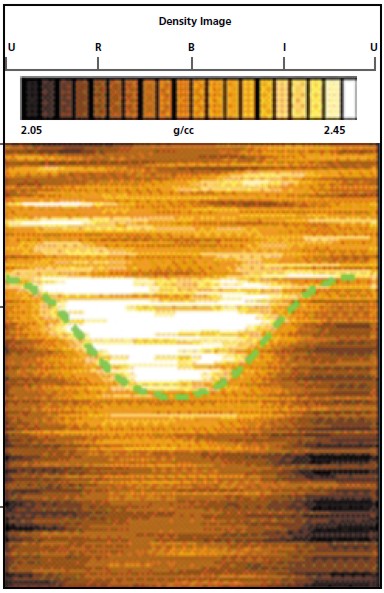
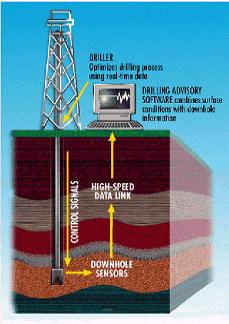
The LWD concept
 LWD density image log (not available as a wireline log), black is
low density (shale or porous), LWD density image log (not available as a wireline log), black is
low density (shale or porous),
white is high density (tight).
Measurement While Drilling (MWD) Is a term used to
describe drilling related measurements made at the
surface or made downhole and transmitted to the
surface while drilling a well. The terms MWD and LWD
are sometimes used interchangeably, but we like to
think of LWD as the process of obtaining information
about the rocks (porosity, resistivity, etc) and MWD
as obtaining information about the progress of the
drilling operation (rate of penetration, weight on
bit, wellbore trajectory, etc). MWD today often
refers to geosteering measurements made to help
decide on changes to the wellbore path.
The measured
results are stored in LWD and MWD tools and some of
the results can be transmitted digitally to surface
using mud-pulse telemetry. Certain
MWD systems have the capability of receiving encoded
control commands which are sent by turning on and
off mud pumps and/or changing the rotation speed of
the drill pipe. These messages allow the drill bit to be
steered in a desired direction
LWD technology was
developed originally as an enhancement to the earlier MWD technology to completely or partially replace
wireline logging operation. With the improvement of the technology
in the past decades, LWD is now widely used for drilling (including
geosteering), formation evaluation, especially for high angle wells.
In frontier areas, deep water offshore, and critical wells anywhere,
the real time log data as the well is drilled may be critical to the
success and economics of the well.
 LOGGING WHILE DRILLING TOOL STRING (BOTTOM HOLE ASSEMVLY - BHA) LOGGING WHILE DRILLING TOOL STRING (BOTTOM HOLE ASSEMVLY - BHA)
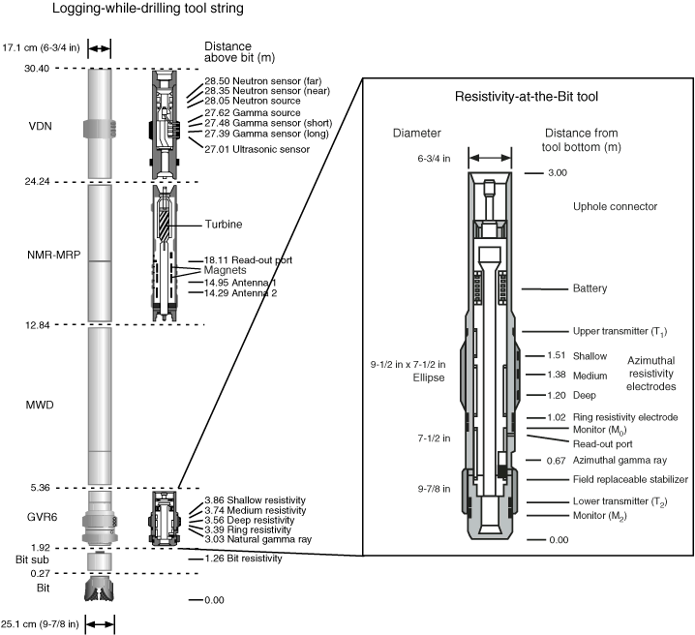
Schematic drawing of a typical LWD tool string with multiple
sensors.
Over the years, a
majority of the conventional wireline measurements have been made
available in LWD. Certain new measurements are available only in LWD,
for example density imaging logs. The following is a
list of available measurement in LWD:
Natural gamma ray
Spectral gamma ray
Azimuthal gamma ray
Gamma ray close to drill bit.
Density and photoelectric index
Neutron porosity
Borehole caliper
Ultra sonic azimuthal caliper
Density caliper
Attenuation and phase shift resistivities at different transmitter
spacings
and frequencies
Resistivity at the drill bit
Deep directional resistivities
Compressional slowness
Shear slowness
Density borehole images
Resistivity borehole images
Formation tester and sampler
Formation pressure
Nuclear magnetic resonance
Seismic while drilling
Vertical seismic profile
 LOGGING WHILE DRILLING EXAMPLES LOGGING WHILE DRILLING EXAMPLES
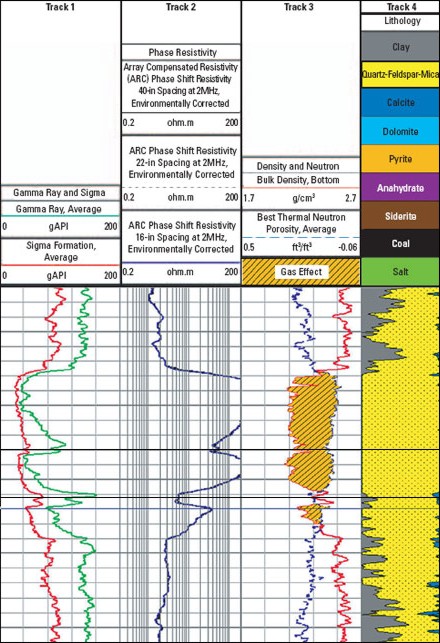
Resistivity, density, neutron, gamma ray, and capture cross
section (sigma) recorded while drilling. The sigma curve (scaled
in GR units in Track 1) shows the lower part of the sand to be
clean, even though the GR is somewhat radioactive (confirmed by
constant density neutron crossover). Gas crossover
is more obvious on LWD logs as there is little flushing of
moveable hydrocarbons due to limited time for drilling fluid
invasion. If the LWD is run while tripping or on a wiper
trip, invasion can be deeper, and may vary from one run to
another.
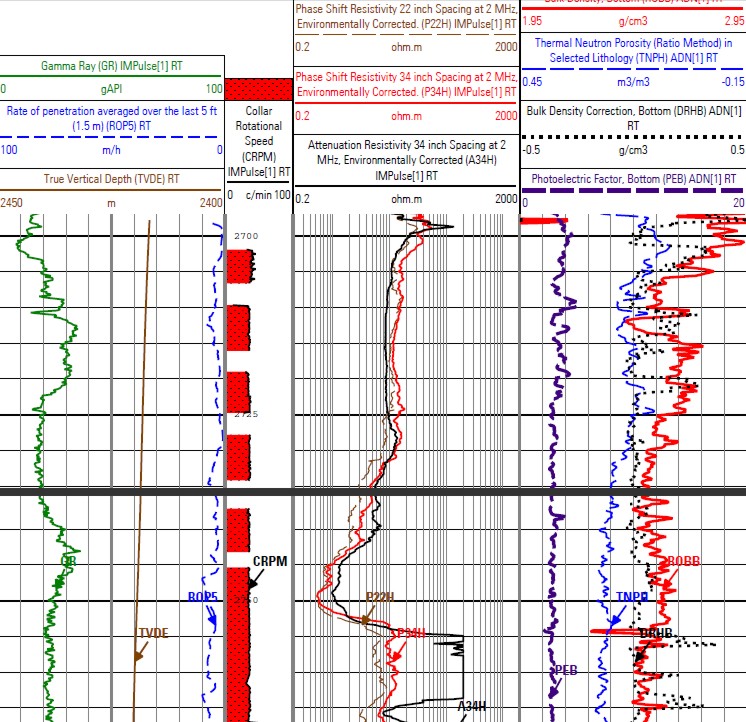
LWD log in horizontal well. GR and true vertical depth
(TVDE) in Track 1, resistivity in Track 2, porosity and PE
curves in Track 3. The low resistivity below the heavy
black line on the log indicates that the well dropped below the
oil water contact (TVD > 2418 +/-). Much of the horizontal leg
beyond this point is in or near the water.
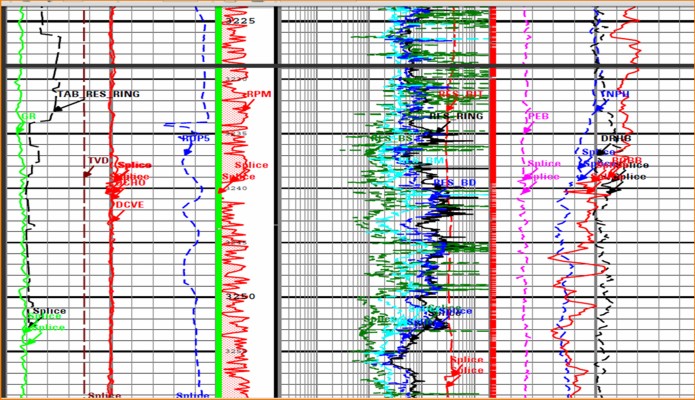
This LWD example shows GR, TVD, and caliper in Track 1, with drilling
characteristics such as rate of penetration, torque at the bit,
and bit RPM. Track 2 gives shallow, medium, and deep resistivity
- separation between the curves and spikes to the left indicate
fractures in an oil reservoir. PE, density and neutron curves
are in Track 3. These logs were run in short "wiper trip" segments and
spliced in the computer - each curve is spliced at a different
depth because of their position in the tool string. Some curves
may not splice perfectly due to changes in the invasion profile
over time.
|

